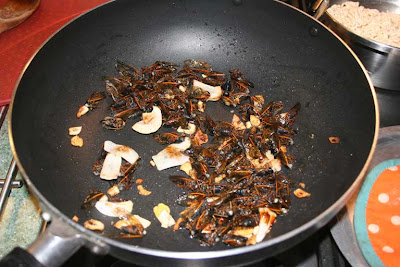 |
| Cicadas have emerged in about 17 states, including Missouri, Kansas, Illinois, Mississippi and south. |
What’s That Noise?
About 10 days ago I was traveling through central Mississippi for a State Master Gardeners Conference. All along the highways as I drove, I could hear the songs of cicadas. I knew ours at home would be emerging in a few days, as the great cicada hatch of 2011 moved northward.
We’re currently in the middle of the emergence of the 13 year cicada or periodic cicada (known as the Magicada). Cicada burrow upward out of the ground and the nymphs climb onto trees, bushes, even tires, where they fasten their claws and the cicadas emerge, leaving behind the old skin.
Cicadas don’t harm trees or shrubbery, and they don’t eat leaves of plants like locust or grasshoppers. The larger portion of the cicada’s 13 year life cycle (or 17, in the instance of the 17 year cicada) is spent underground, feeding on the sap of tree roots. Once they emerge, they are only alive for about 6 weeks to breed, then they die.
 |
| All that's left is the "shell" once the cicada has emerged and grown wings. |
Cicada “nymphs” once out of the ground and having shed their old skin, climb upward, then fly off. The males are the ones making the noise, trying to attract a mate. Once they have mated, the female flies onto a limb tip of a tree and insert an egg into a tender twig. The egg grows, becoming a small grub which falls to the ground. Once on the ground, it burrows downward to tree roots where it will live and grow for another 13 year cycle. Tender limb tips near the outer edge of trees may fall off, but the pruning is generally helpful, and doesn’t harm the tree.
 |
| This one's been out of the ground for a few hours and its wings have matured so it can fly. |
There’s no control for these insects, nor is there any need to control them. True, they can be irritating, but even if you sprayed them with insecticide, more would fly in from next door - plus the insecticide would kill off songbirds, cats, dogs and other things that find cicadas to be a delicacy. Be patient, they will be gone in a few short weeks and won’t return for another 13 years.
 |
| Cicada killer wasp. |
A natural predator of cicadas (besides dogs, cats, birds and humans) is the cicada killer wasp, a flying insect that looks very much like a hornet. Unlike hornets, this wasp lives in a single hole in the ground with just a male and female. While cicada killer wasps can sting if seriously provoked, even then would rather fly away then sting. These wasps are harmless and do a service to homeowners by controlling cicadas.
Cicadas are quite edible and you’ll find plenty of recipes on the internet. We cooked up a batch for supper this week, stir-frying them with garlic, ginger and shallots, then adding Chinese noodles and cilantro. Next I’m going to try the German chocolate cicada cake recipe I found.
Some sources suggest par-boiling the cicadas first (they're also known as "sky prawn" due to the fact that in some regions of the world, they are collected in large nets and meals made from this free protein source).
I fried these in a hot skillet, right after stir-frying some garlic, shallot and ginger. When that was ready, I added some soy sauce - actually Tamari - then added the noodles and some sugar snap peas, with another quick-fry, adding fresh cilantro from the garden just before serving.
Here are some other recipes for you to try.
Chocolate Covered Cicadas
Anything coated in chocolate will be tasty!
8 squares (about 4 oz.) dark chocolate
30 *dry roasted cicadas
*Roast young cicadas in the oven for 15 minutes at 225F.
Melt chocolate in a double-boiler over low heat. Dip insects in chocolate, place on wax paper let the chocolate harden. Sprinkle with coarse-ground sea salt.
Cicada Wontons
4 oz. package cream cheese, room temperature
30 freshly hot water boiled cicadas (boil for 3 minutes and drain)
1 Tablespoon freshly chopped chives
1 package Wonton wrappers
Drop approximately 1 teaspoon of cream cheese on each of the wonton wrapper, add a pinch of fresh chives, then place 1 cicada on each of the wrapper. Fold in corners and seal with egg white. Fry in hot oil until crispy and brown. Serve with sweet and sour sauce.
For recipes of herbal things that don't involve cicadas, visit my website for my homemade crackers, dips, salsas and other foods, which all include herbs.
Happy Gardening!



3 comments:
You have got to be kidding? Did you eat them? Yvette
Yes of course we ate them. We had guests for dinner and all of us not only ate them but cleaned our plates.
It would be difficult to categorize cicadas, they aren't animals, because they live completely on plants, I'd think they were more plant than animal. We adventurous gastronomes happily dine in both worlds. Thanks for your comments!
Post a Comment